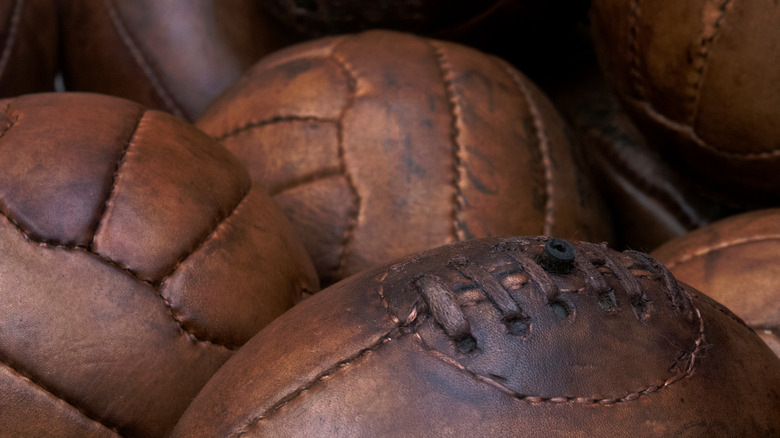Why Were Rugby Balls Originally Made With Pig Bladders?
Have you ever wondered why rubgy balls and footballs are called "pigskins" when everyone knows they're made of cowhide leather? How about why they are that weird oval shape when most other balls are round (aside from aerodynamics)? Would you believe us if we told you it's because they used to be made from the internal organs of a pig?
But let's go even farther back from there. As early as the 1800s, sports enthusiasts used to play ball with hogs' heads (via The Guardian). Before that, historians have even reported that in post-war battles hundreds of years ago, English warriors would play football (American soccer) with the heads of their enemies in celebration.
Rugby, soccer, and football alike are all known for being a bit dangerous, with players being no stranger to season-ending — and sometimes career-ending — injuries. So really, it's no surprise that their origins were even more brutal.
Let's toss around the old pig ... bladder
The town of Rugby, England, is where the sport gets its name, and it's also where the idea of the pig bladder rugby ball started. Although the Gilbert Rugby company is credited with some of the first designs of the oval-shaped pig bladder rugby ball (via World Rugby Shop), other sources say it was both Gilbert and local leather bootmaker Richard Lindon who supplied equipment to the local Rugby School along with Gilbert's competing shops (via Rugby Football History). Although it's unclear when it was officially invented, several sources claim the mid to late 1800s, while Gilbert's site says (via Gilbert Rugby) that the "fame and reputation" of Gilbert Rugby balls was "growing" by 1851, with awards won in 1851 and 1862.
Regardless of their creator, these pig bladder balls were encased in leather for durability, and the bladder itself was inflated by lung power alone through a clay valve before being knotted at the end (via The Guardian). William Gilbert was famous for his lung power back in the day, but despite the impressive feat, one could imagine the complications involved when the only protection between the inflator's mouth and an animal's bladder was a small tube.
Evolution was Imperative
This original design, before inflation, resembled a deflated balloon and was extremely elastic (via Time). Earlier versions of the game relied heavily on long-drop kicking and placing, which, according to James Gilbert, Gilbert's nephew, was the reason for the oval-shaped pig bladder design (via World Rugby Shop). But they were not as durable as modern balls, often springing leaks and needing to be filled with material like straw. However, a ball losing air is certainly less tragic than one's lungs losing the ability to breathe it.
Pig bladders were not sterile and carried a plethora of bacteria that could cause those inflating them to catch lung diseases. Before modern medicine, this didn't call for a quick trip to urgent care — it could mean death. And it did, for some. Richard Lindon took charge of the evolution from pig bladder to rubber when he invented the first rubber bladder in 1875 to improve passing and handling (via Gilbert Rugby). But this stroke of genius only came after tragedy — the idea came when his wife died from a disease caught from blowing up pig bladders (via The Guardian), and when his rubber bladder invention proved to be too difficult to blow up, he invented the first hand air pump that became the standard for inflation for decades to come (via World Rugby Shop).
Sometimes change only comes following tragic circumstances. Much like Marie Curie dying from her own radiation studies, it took the life of a pioneer to evolve the game.


